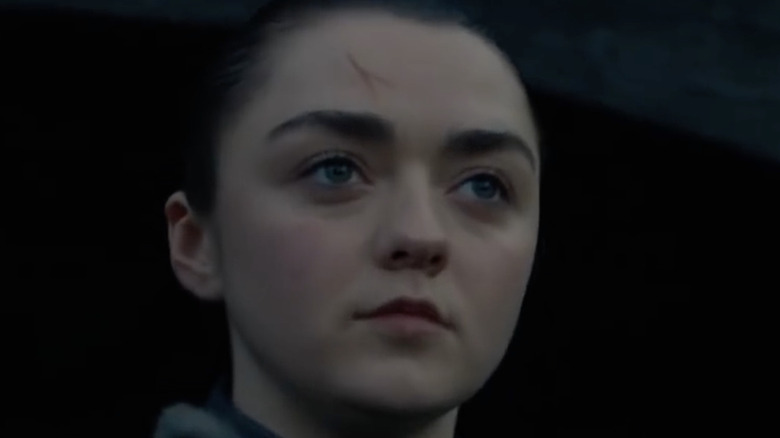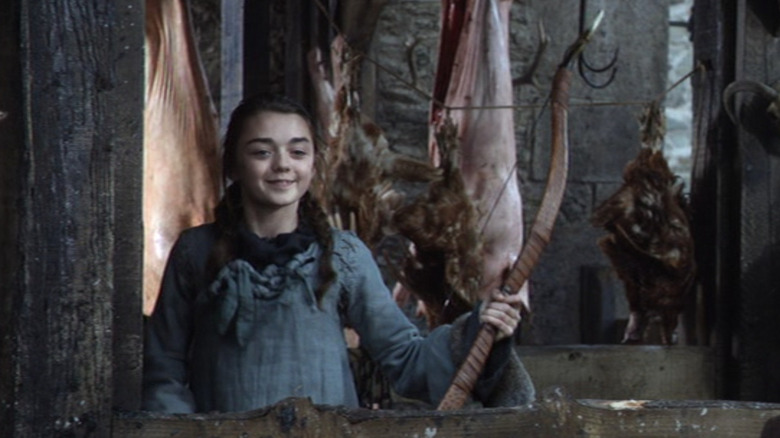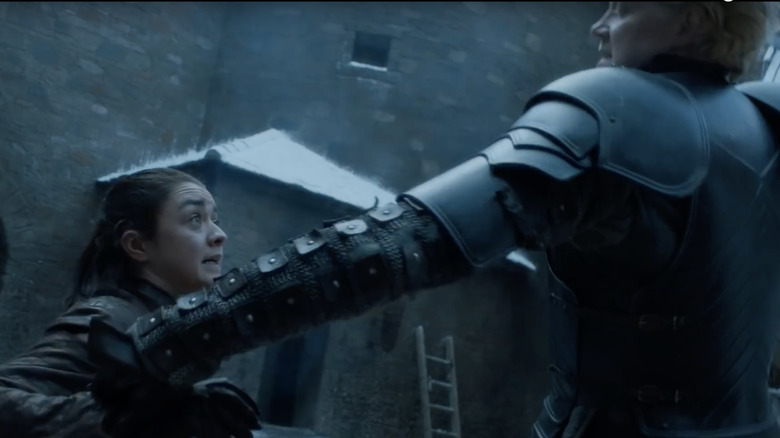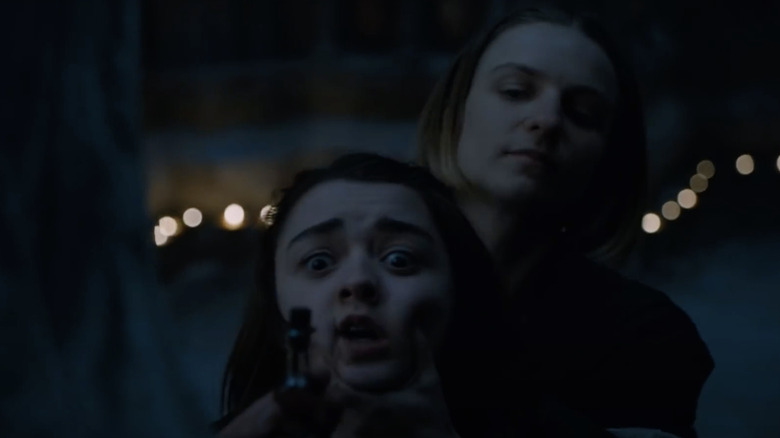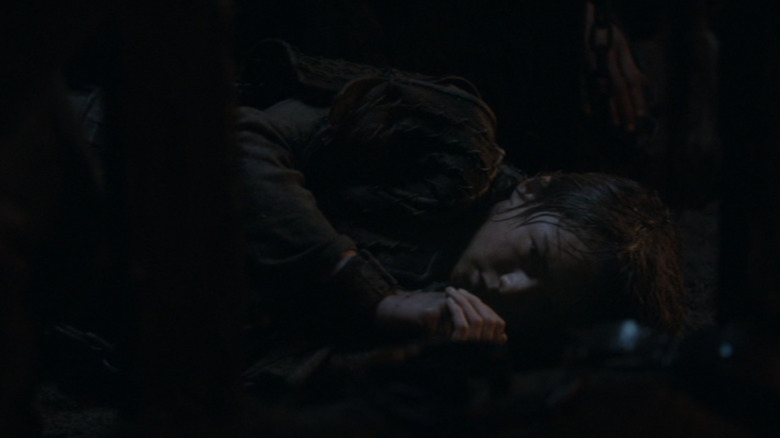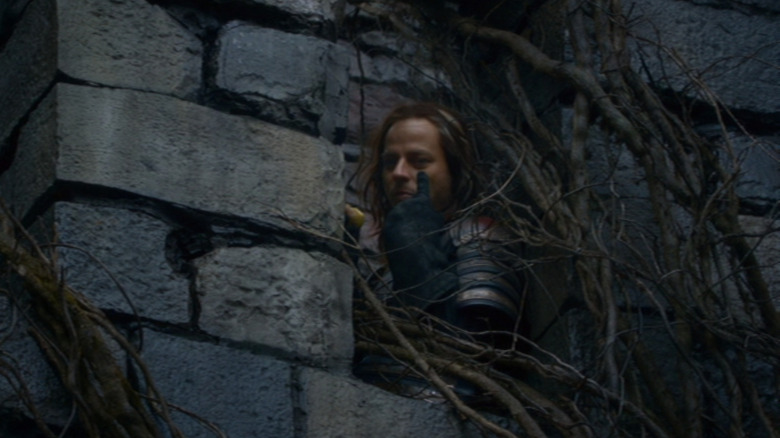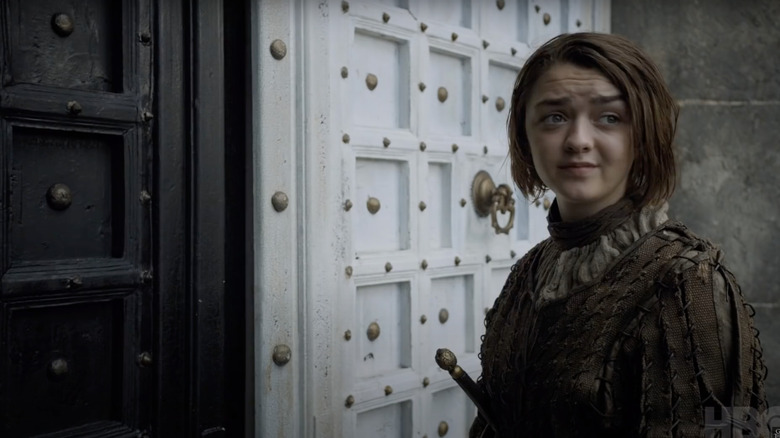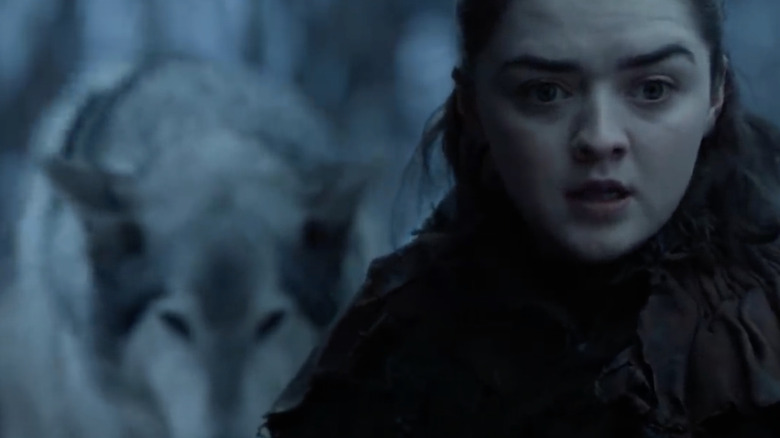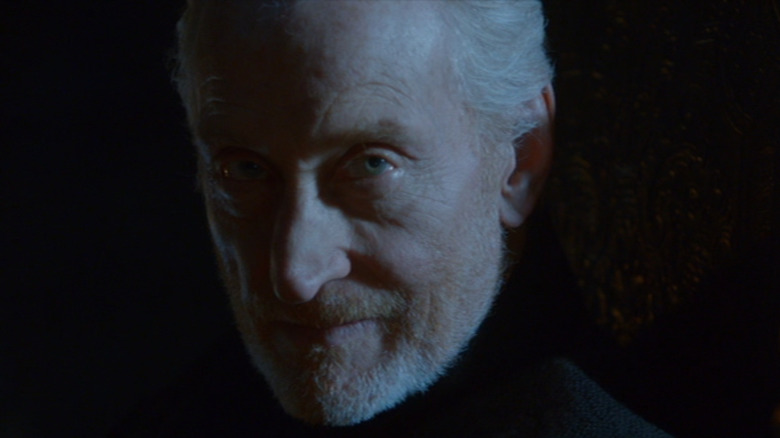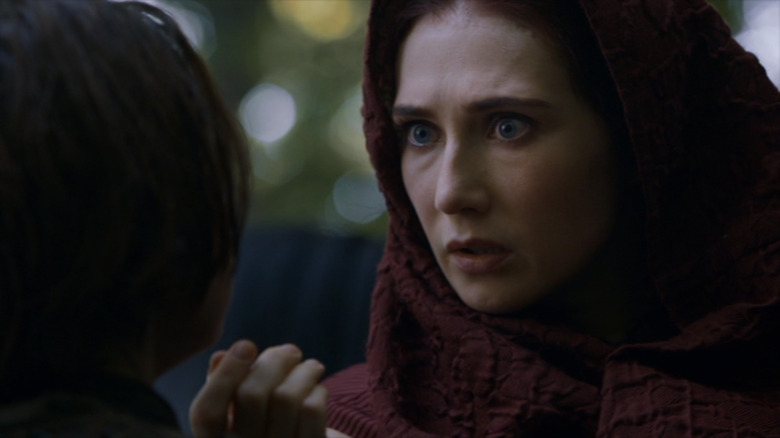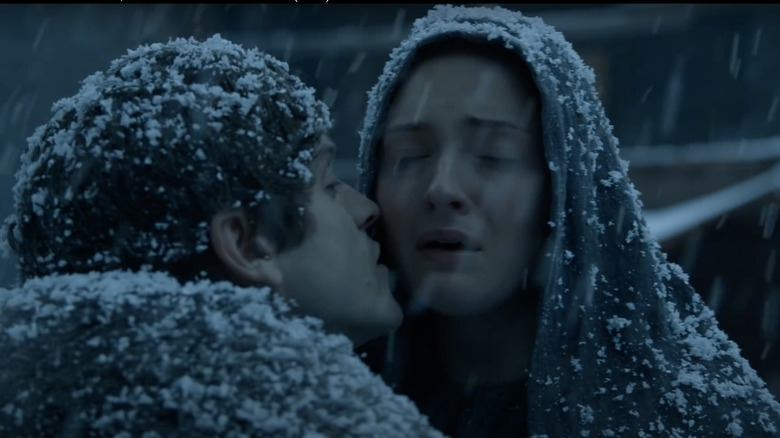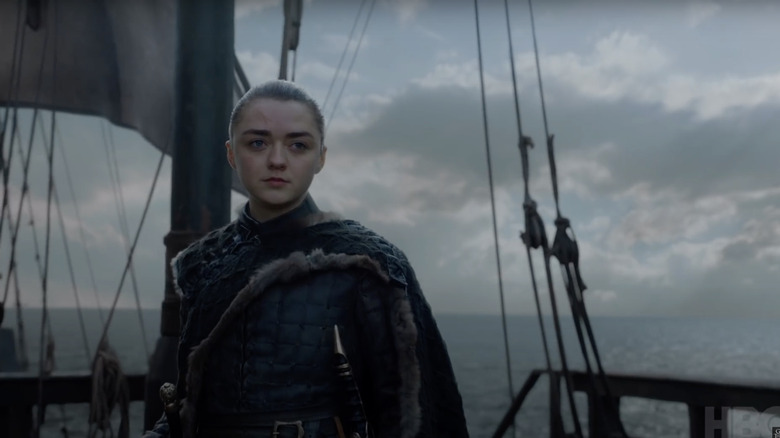This Is How Arya Stark Is Different In The Game Of Thrones Books
Most "Game of Thrones" fans know by now that there are significant differences between the HBO show that mesmerized a generation and the George R. R. Martin book series it's based on. While the first couple seasons of "Game of Thrones" were reasonably faithful to the novels, as time went on, showrunners David Benioff and D.B. Weiss began diverging from Martin's story more and more. As a result, several of the characters from the "A Song of Ice and Fire" series were almost unrecognizable to readers by the time "Game of Thrones" concluded its widely-derided final season.
Among those characters is Arya Stark, one of the story's most popular protagonists in any medium. Ned Stark's murderous younger daughter was brought to life spectacularly by actor Maisie Williams — who became one the show's breakout stars — but even from the very first episode, it was clear that this version of Arya wasn't exactly the one that "A Song of Ice and Fire" readers knew and loved.
Some of the changes are bigger than others, but all of them have an important impact on Arya's personality and narrative. It's time to put on a brave face (literally) and investigate all the ways in which Arya Stark is different in the books — and if you're someone who has yet to experience this story in either its written or televised forms, it's also time to stare down the God of Spoilers and say, "Not today."
She's not an archer
Like most "Game of Thrones" characters, Arya was basically unchanged throughout her storyline in the first season, which included being given a sword by Jon Snow, taking "dancing lessons" from Syrio Forel, and making her first kill in the form of a nosy stableboy.
But her very first appearance in the very first episode contained a moment that contradicted Martin's books. It comes when her younger brother, Bran, is practicing archery in the castle yard of Winterfell, and not doing great. With encouragement from Jon and Robb, he draws the bowstring back dramatically one more time — only for Arya, standing behind him, to hit the bullseye herself. Her archery skills are part of the series from that point on, including a Season 3 scene in which she gets a few tips from an outlaw called Anguy.
Arya might be a killer in Martin's books, but she is certainly not an archer. In fact, this point is made explicitly clear when she's captured by Anguy and his fellows, the Brotherhood Without Banners, in "A Storm of Swords." After seeing his prowess with archery, she thinks to herself "I'm going to shoot a bow," and the book continues, "She loved swordfighting, but she could see how arrows were good too." It's not a massive change, but it's interesting that Weiss and Benioff establish from the beginning that Arya has training with weapons — despite the fact that it's unclear who in Winterfell would have dared to teach her.
She's not a warrior
One of the reasons Arya's archery skills are notable is that those skills fit in with a broader trend regarding her character in "Game of Thrones" — namely, that she's a bad-ass. Her proficiency with a bow and her training with Syrio Forel are just the beginning; by Season 4, she's casually murdering people alongside Sandor Clegane, and after completing her training with the House of Black and White in Season 5, she basically spends the rest of the show as an unstoppable murder machine.
In Season 7, she duels Brienne of Tarth to a standstill, proving that her abilities as a warrior are equal to those of the Seven Kingdoms' greatest knights, and in Season 8, she single-handedly wins the Battle of Winterfell by killing the Night King. It's little wonder that she regularly finds herself at the top of lists ranking the best fighters in "Game of Thrones."
The books aren't finished, so there's a chance Arya will eventually reach such a level, but at this point it really doesn't seem likely. Still currently in the midst of her House of Black and White training, it seems likely that Arya will become a formidable assassin — it would be surprising if her retribution against House Frey doesn't make it onto the page — but nothing about her story so far suggests she'll be out-dueling knights and winning wars. That's not the kind of killer Arya is, and it doesn't fit with the kind of tale Martin is telling.
She actually trains to be an assassin
If you're wondering why it's so unlikely that the book version of Arya will ever achieve her TV counterpart's lofty combat capabilities, it's largely because of the training she receives from the notorious assassin order known as the Faceless Men.
Both show and books have a character called "the waif," but in the books she is a patient teacher, instructing Arya on languages, deception, and the properties of various poisons. While Arya is made to spend some time blind, and the waif does teach her how to deal with it, she's nothing like HBO's grim-faced terminator that Arya has to kill in the dark in order to win acceptance. Arya's advancement in the books is a reward for her subtlety, not her fighting skills, because Arya is being trained as an assassin, not as a warrior — if she ever finds herself in a situation where she's forced to directly battle an opponent after an extended chase sequence, she's doing it wrong.
Also notable is the fact that in "Game of Thrones," Arya struggles with the House of Black and White's demand that she give up her name, whereas in the books, giving up her name is her idea. Arya's story is very much tied into the idea of names, and she uses many different ones over the course of the series. Ridding herself of her "Arya Stark" identity is something she approaches willingly ... though she never quite manages to bury it for good.
She comes up with the list of names on her own
The connection between Arya and names comes up most famously in the list of them that she recites to herself every night before going to sleep — names of people she's going to kill.
However, just as they denied her agency in giving up her own name, Weiss and Benioff also had Arya take the idea for her vengeance list from someone else. It happens in Season 2, when she's traveling with a Night's Watch ranger named Yoren, who is attempting to take her home to Winterfell on his way back to the Wall. Speaking to Arya about how to deal with the pain of her father's death, Yoren tells her the story of Willem, a young man who killed Yoren's brother. Yoren became obsessed with revenge, chanting Willem's name to himself every night before he went to sleep, until finally he killed Willem and took refuge at the Wall. While the story is meant to be a lesson about not letting thoughts of revenge poison your mind, Arya focuses on the chanting of Willem's name, and begins chanting her own vengeance prayer to herself.
It's not a bad scene by any stretch, but it has the effect of dampening one of Arya's most disconcerting character traits: She's a child whose experience of the world has led her to create her own personal kill list. Not quite the same thing as misunderstanding the moral of someone else's story.
She wastes her wishes
It might not play out the same way in HBO's version, but the combination of Arya's youth and her bloodthirsty nature does lead her to make mistakes, particularly when she finds herself put to work in the castle of Harrenhal after being captured in "A Clash of Kings." In both the books and the show, this is when she's approached by the mysterious Jaqen H'ghar, who offers to kill three people of her choosing in exchange for Arya having previously saved his life and the lives of his two companions. Her choices in the show are fairly straightforward — she names the Tickler, a soldier who tortures prisoners; Amory Lorch, who has discovered Arya reading a stolen letter concerning troop movements; and finally Jaqen himself, promising to un-name him if he helps her escape Harrenhal, which he does before changing his face and departing.
Arya's "three wishes" in the book version are far more selfish and dramatically less effective. She first names a soldier named Chiswyck who has done terrible things but is of no real consequence, then Weese, her own violent and cruel taskmaster. Finally realizing that she could be putting Jaqen's favor to better use, she names Jaqen and demands he help a contingent of imprisoned Northmen take control of Harrenhal, which he does ... only to discover after the fact that the Northmen had a plan to take control of the castle, anyway. Afterward, Jaqen departs, while Arya stays behind — her eventual escape is by her own design.
She isn't trained by Jaqen H'ghar
One good idea "Game of Thrones" had, in terms of character economy, was to bring Jaqen back in Season 5, when Arya shows up at the House of Black and White. Considering Jaqen was the one who gave Arya the iron coin she uses to get to Braavos, along with the words "valar morghulis," it makes sense that he would be the one to train her upon arrival. Which is why it's a bit surprising when, in the books, he is very much not that. Arya's head trainer, so to speak, is a person known only as "the kindly man," and while he's almost certainly more than he appears to be, he's also definitely not Jaqen. We know this, despite the fact that the Faceless Men have the ability to look like other people, because Jaqen is on the other side of the world.
Every prologue and epilogue in "A Song of Ice and Fire" is told from the point of view of somebody who is about to die, and the prologue for "A Feast for Crows" is no different. It features a man named Pate, a novice at Westeros' center of academic learning, the Citadel, who is killed by a man matching Jaqen's description (Jaqen then uses Pate's face to impersonate him). This is all part of a sub-plot involving the Citadel that was cut from the show entirely, thus freeing up Jaqen to play the role of Arya's trainer.
She's a warg
The abandoned Citadel plotline hasn't fully taken shape in the books yet, but we know it has something to do with the fact that magic, which had been gone from the world since the death of the last dragon, is beginning to return.
But magic doesn't have much of a place in "Game of Thrones," even after Daenerys Targaryen's dragons are born, and nowhere is this more evident than in its brutal dismissal of the Stark direwolves, and the Stark kids' ability to warg (magically inhabit the bodies of other creatures). Weiss and Benioff allow Bran to be a warg in the show, but in the books, Arya, Jon, and Rickon have also demonstrated the ability (and the only reason Robb and Sansa haven't is because they and/or their wolves are dead).
Not only has Arya found herself with the power to see through the eyes of nearby cats, but she regularly inhabits the mind of her lost direwolf, Nymeria, in her dreams. It could be convincingly argued that it was Arya's unconscious influence as a warg that caused Nymeria to drag the corpse of Arya's mother, Catelyn Stark, out of the river where it had been dumped, ultimately resulting in her transformation into Lady Stoneheart. But the show cut that entire plotline too, and the Nymeria thread is wrapped up in a brief scene where Arya randomly meets her and lets her go — just another instance of Weiss' and Benioff's head-scratching disinterest in the direwolves.
She never meets Tywin Lannister
One of the things that made "Game of Thrones" great in the early seasons was its ability to faithfully adapt the best parts of the original source material while also finding space for brand new interactions between characters on the margins of the main story. Season 1 gave us memorable moments between King Robert Baratheon and his wife, Cersei, a glimpse into their troubled married life that Martin never gave his readers, and in Season 2, we got several acclaimed scenes between Lord Tywin, patriarch of House Lannister, and his cupbearer during his stay at Harrenhal, a common serving girl who is secretly Arya Stark. Their conversations, and the brilliantly acted interplay between Maisie Williams and Charles Dance, are one of the highlights of the season, though they have little functional impact on the plot.
Sadly, not only does this interaction never take place in the books, but Arya and Tywin never meet in person. They are both in Harrenhal, but Arya is basically a slave, and Tywin has other, better-bred servants to attend him. The cupbearer story comes later in "A Clash of Kings," after Tywin leaves and Harrenhal is taken by the Northmen, at which point Arya, her true identity still unknown, serves as cupbearer for the castle's new master, Roose Bolton. The scenes of Arya serving Lord Bolton are notable in that they contain clues to his eventual betrayal of her brother Robb, but they can't hold a candle to Williams and Dance.
She never meets Melisandre
Another HBO interaction that never takes place in the books is the Season 3 meeting between Arya and the Red Priestess, Melisandre, though this one is remembered with significantly less enthusiasm.
If Melisandre is a harbinger of doom, her meeting with Arya is a harbinger of "Game of Thrones'" unfortunate tendency to have characters seemingly teleport across Westeros with no regard for distance or travel time — last seen leaving the court of King Stannis on Dragonstone, Melisandre suddenly appears in the Riverlands, where she encounters the Brotherhood Without Banners and makes off with Gendry, Arya's friend and the bastard son of King Robert.
This is done primarily as an excuse to get Gendry to Dragonstone so that he can fill the role played in the books by another of Robert's bastards, Edric Storm, but in the process, Melisandre looks Arya in the eyes and sees a vision of her murderous future. This is a rather ham-fisted adaptation of a scene in "A Storm of Swords" in which the Brotherhood, with Arya in tow, encounters a dwarf woman with the gift of prophecy known as the Ghost of High Heart, who refers to Arya as "wolf child," "blood child," and "dark heart."
As with Jaqen H'ghar, we understand the urge to use Gendry and Melisandre in these roles rather than introducing two new characters, and the Arya/Melisandre interaction pays off in the last season — but it was a long and unnecessarily winding road to get there.
She has multiple imposters
Even if Arya wasn't a point-of-view character in the books, we'd know for a fact that Melisandre has never met her thanks to "A Dance With Dragons." In that book, we get a chapter from Melisandre's perspective for the first time, and she has a vision of a young woman fleeing an unwanted marriage and seeking refuge at the Wall, where Jon Snow has recently been elected Lord Commander of the Night's Watch. We can tell she's never met Arya because she assumes the young woman in question is Arya — an assumption that comes crashing down around her ears when it turns out to be a Northern noblewoman named Alys Karstark.
Of course, Alys isn't the only person who gets mistaken for Arya over the course of the novels. The whole reason Melisandre assumes it's Arya in her vision is because she believes, along with the rest of the world, that Arya has been married off to the sadistic Ramsay Bolton as part of his family's traitorous deal with the Lannisters. In fact, the girl in question is a servant's daughter named Jeyne, formerly the best friend of Sansa Stark — in the show, Jeyne is cut out, and Sansa herself is forced to marry Ramsay in an extremely controversial diversion from the source material.
The device of others using Arya's name and being mistaken for her fits beautifully with the character's overall themes, but that wasn't enough to keep Weiss and Benioff from ignoring it completely.
She's not an explorer
Again, we can't know the direction Arya's character will take over the course of the remaining, as-yet-unpublished books, but the way her story comes to an end in the final episode of "Game of Thrones" is dubious — to say the least.
In that episode, Arya reveals her plan to sail west, exploring the sea beyond their maps and discovering what lies "west of Westeros." Even in the show, it's not a decision that makes much sense — Arya has never been an explorer, and if we had to guess, we'd say the idea was just to pay homage to the iconic shot of her final scene in Season 4, when she finally manages to sail away from Westeros thanks to Jaqen's iron coin.
In the context of the books, however, it's even more baffling, especially considering that when Arya boards that ship at the end of "A Storm of Swords," she asks the captain to take her to the Wall so that she can be reunited with Jon. Having seen the iron coin, however, he ignores her request, taking her to Braavos and the House of Black and White instead.
Her journey across the Narrow Sea, therefore, had nothing to do with exploration and wasn't even her original intent. There have been some theories as to what might have inspired her show-ending decision, but the likeliest explanation is that Arya's character arc was just another casualty of "Game of Thrones'" overall failure to stick the landing.
